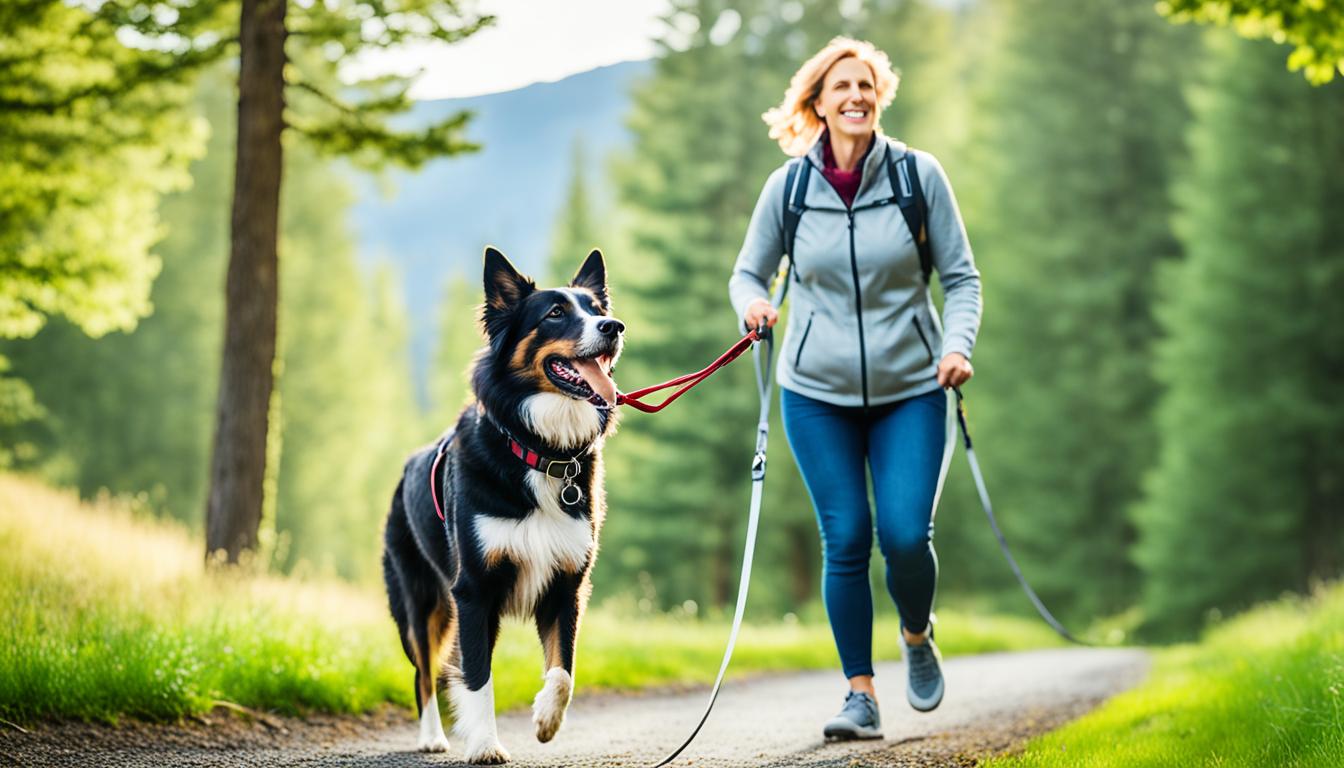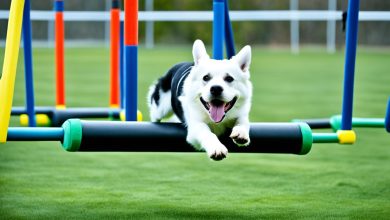Leash Training Tips for Happy, Obedient Dogs

Leash training is key for dog owners who want fun and safe walks. It gets tough when dogs pull on the leash or get too excited. So, starting leash training early is key.
Experts suggest you act as the pack leader. Wait for your dog to calm down before you start walking. For energetic dogs, playing fetch or running at the park helps burn off energy.
It’s important to break old habits and make new ones in leash training. Teach dogs to walk without pulling by using positive rewards and being consistent. This makes walks nicer and strengthens the bond between you and your dog.
Key Takeaways:
- Start leash training from the beginning to establish good habits.
- Become the pack leader and wait for your dog to calm down before walks.
- Drain excess energy through activities like playing fetch or running.
- Teach your dog to walk on a loose leash or heel for polite and calm walks.
- Use positive reinforcement and consistency throughout the training process.
How to Walk Your Dog on a Loose Leash
Loose leash walking teaches dogs to stay close without pulling on the leash. It makes walks with your dog more enjoyable. Here’s how to teach your dog this useful skill.
Start Indoors
Start training inside where it’s quiet with fewer distractions. Call your dog happily and give them a treat when they come to you. Walk a bit and reward them for walking by your side. Keep practicing until your dog follows you eagerly.
Add the Leash
After your dog learns to walk calmly indoors, add the leash and collar or harness. Keep training in a calm place, like a quiet street or your backyard. Use treats and praise to teach them to walk on a loose leash.
Maintaining Distance
Keep a distance of four to five feet from your dog while walking. This gives them room to explore but stay near you. A consistent distance teaches them their walking area.
Being positive is key to training. Be patient, consistent, and always praise your dog. Remember, dogs learn at their own pace. Adapt your training to meet their needs.
| Benefits of Loose Leash Walking | 1. Enhanced safety for both you and your dog |
|---|---|
| 2. Improved control and focus during walks | |
| 3. Increased bonding and relationship with your dog | |
| 4. Enjoyable and relaxed walks |
Troubleshooting Leash Training Issues
Leash training can bring joy to you and your dog. Yet, some challenges may arise. One main challenge is when your dog pulls on the leash. It’s key to stay calm and not move. This teaches your dog that pulling won’t work. Avoid yanking or dragging your dog, as it could worsen the issue.
Another issue is when dogs lunge at things like other dogs or cars. To prevent this, be ready with a treat or toy. This draws their attention away before they lunge. Moving your dog further from distractions helps them focus on you. Being consistent is crucial to overcome this behavior.
Dogs often bark at other dogs during walks. To lessen this, engage your dog in activities before the walk. Exercise and mental games tire them out. If your dog keeps barking, redirect their focus to you. Reward them for paying attention to you instead of barking. Slowly decrease treats as you keep addressing this issue to improve your dog’s walk behavior.
FAQ
Can leash training help improve my dog’s behavior?
When should I start leash training my dog?
How can I teach my dog to walk on a loose leash?
What should I do if my dog pulls on the leash?
How can I prevent my dog from lunging at distractions?
What can I do if my dog barks at other dogs during walks?
Source Links
- https://tullystraining.com/blog/leash-training-how-to-walk-a-dog-that-pulls
- https://theonlinedogtrainer.com/leash-training-your-dog-when-its-too-excited-to-walk/
- https://www.akc.org/expert-advice/training/teach-puppy-walk-leash/




